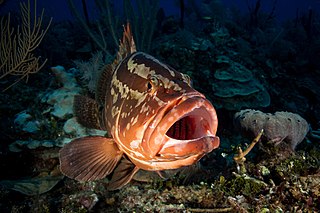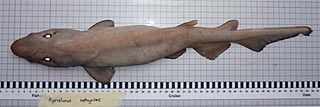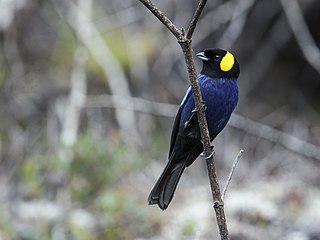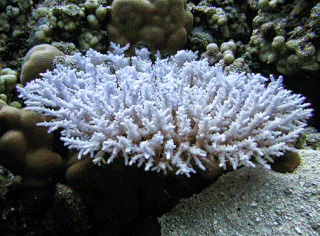
The Nassau grouper is one of the large number of perciform fishes in the family Serranidae commonly referred to as groupers. It is the most important of the groupers for commercial fishery in the West Indies, but has been endangered by overfishing.

Fraser's dolphin or the Sarawak dolphin is a cetacean in the family Delphinidae found in deep waters in the Pacific Ocean and to a lesser extent in the Indian and Atlantic Oceans.

Cranchiinae is a subfamily containing four genera of glass squids.

The spot-tail shark, or sorrah shark, is a species of requiem shark, in the family Carcharhinidae, found in the tropical Indo-West Pacific Ocean between latitudes 31°N and 31°S from the surface to a depth around 72 m (236 ft). This shark grows to about 1.6 m. It is fished commercially over much of its range and the IUCN considers it to be near threatened.

Liocranchia is a genus of glass squid from the family Cranchiidae. They are moderate-sized with a long, spindle-shaped mantle which tapers to a point at the rear and they can attain mantle lengths of 250 millimeters (9.8 in). The species in Liocranchia have a cosmopolitan distribution in tropical and subtropical oceans although it has been suggested that on especies, Liocranchia reinhardti is associated with land masses. In seas off Hawaii waters, L. reinhardti undergoes vertical migrations while L. valdiviae occurs in deep water and is sedentary. They are eaten by many oceanic predator species.

The white ghost catshark is a shark of the catshark family Scyliorhinidae found in deep water in the northeast Atlantic between latitudes 57°N and 58°N. A deep-water catshark known from the eastern North Atlantic from depths of 1,014 to 1,800 m, it is known from only a limited number of specimens. It reaches a maximum of 54 cm or 1.7 ft total length which is a medium size for the Apristurus genus.

Bagropsis reinhardti is a species of long-whiskered catfish. This species reaches about 22.7 cm (8.9 in) in standard length and is endemic to Brazil where it is found in the Das Velhas River basin in São Francisco River drainage. It is considered a threatened species by Brazil's Ministry of the Environment.
Mimosiphonops reinhardti is a species of caecilian in the family Siphonopidae. It is endemic to Brazil. It is only known from the holotype collected from "Brasilia" in 1878, probably somewhere in eastern Brazil. The specific name reinhardti honors Johannes Theodor Reinhardt, Danish zoologist and herpetologist who collected the holotype. Common name Reinhardt's caecilian has been proposed for this species.

The yellow-scarfed tanager is a species of bird in the family Thraupidae. It is found in forests in the Andean highlands in Peru.

Hyporthodus nigritus, the Warsaw grouper, is a species of marine ray-finned fish, a grouper from the subfamily Epinephelinae which is part of the family Serranidae, which also includes the anthias and sea basses. It is found in the Western Atlantic from Massachusetts to the Gulf of Mexico, Cuba, Trinidad, and south to Brazil. Its natural habitats are open seas, shallow seas, subtidal aquatic beds, and coral reefs. It is threatened by habitat loss.

Eels are ray-finned fish belonging to the order Anguilliformes, which consists of eight suborders, 20 families, 164 genera, and about 1000 species. Eels undergo considerable development from the early larval stage to the eventual adult stage and are usually predators.

An anchovy is a small, common forage fish of the family Engraulidae. Most species are found in marine waters, but several will enter brackish water, and some in South America are restricted to fresh water.
L. intermedia may refer to:
Stylaraea is a genus of marine stony corals in the family Poritidae. It is a monotypic genus and the only species is Stylaraea punctata. This coral is native to shallow tidal pools in tropical parts of the Indian and Pacific Oceans.

Acropora muricata, commonly called staghorn coral, is a species of acroporid coral found in the Gulf of Aden, the Red Sea, Indian Ocean, Persian Gulf, Australia, central Indo-Pacific, Japan, Southeast Asia, the East China Sea and the oceanic central and western Pacific Ocean. It is found in tropical shallow reefs, slopes of reefs, and in lagoons, from depths of 5 to 30 m. It was described by Dana in 1846.
Acropora batunai is a species of acroporid coral that was described by Carden Wallace in 1997. Found in protected, shallow reefs, it occurs in a marine environment at depths of up to 44 m (144 ft). The species is rated as vulnerable on the IUCN Red List, with a decreasing population, and is extremely fragile. It can be found over a large area but, overall, is not common.

Acropora paniculata is a species of acroporid coral that was first described by Addison Emery Verrill in 1902. Found in marine, tropical, shallow reefs on the upper slopes, it occurs at depths of between 10 and 35 m. It is classed as a vulnerable species on the IUCN Red List, and it has a decreasing population. It is uncommon but found over a large area, including in five regions of Indonesia, and is classified under CITES Appendix II.
Acropora plumosa is a species of acroporid coral that was first described by Dr. C. C. Wallace and J. Wolstenholme in 1998. Found in marine, tropical, reefs on slopes sheltered from wave action, and on reef walls. It occurs at depths between 10 and 30 m. It is classed as a vulnerable species on the IUCN Red List, and it has a decreasing population. It is not common and found over a large area and is classified under CITES Appendix II.
Freycinet Commonwealth Marine Reserve is a 57,942 km2 marine protected area within Australian waters located off the east coast of Tasmania. It extends to the outer limits of the Australian exclusive economic zone in the Tasman Sea. The reserve was established in 2007 and is part of the South-east Commonwealth Marine Reserve Network. It is the largest reserve of the South-east Network, the area covered is approximately equivalent to about 86% of the land area of Tasmania.
Flinders Commonwealth Marine Reserve is a 27,043km2 marine protected area within Australian waters located off the coast of north-east Tasmania. It extends to the outer limits of the Australian exclusive economic zone in the Tasman Sea. The reserve was established in 2007 and is part of the South-east Commonwealth Marine Reserve Network.













